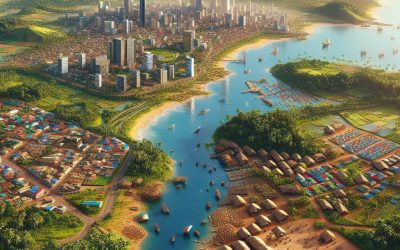History of Côte d’lvoire
Côte d’Ivoire, also known as Ivory Coast, is a country located in West Africa. It has a rich and complex history that has shaped its present-day society and politics. Understanding the country’s past is crucial for its future development and progress. This...
Terrain and Topography of Côte d’lvoire: mountains, valleys, and plains.
Côte d’Ivoire, also known as Ivory Coast, is a country located in West Africa. It is bordered by Liberia and Guinea to the west, Mali and Burkina Faso to the north, Ghana to the east, and the Atlantic Ocean to the south. With an area of approximately 322,463...
Natural Resources of Côte d’lvoire: Where Natural Resources are located In Côte d’lvoire
Côte d’lvoire, also known as Ivory Coast, is a country located in West Africa. It is bordered by Liberia and Guinea to the west, Mali and Burkina Faso to the north, Ghana to the east, and the Atlantic Ocean to the south. The country has a diverse range of natural...
Cultural or Historical Sites of Côte d’lvoire: Important Cultural Landmarks or Historical Sites in Côte d’lvoire
Côte d’lvoire, also known as Ivory Coast, is a country located in West Africa. It is known for its rich cultural heritage and diverse natural landscapes. The country is home to a vibrant mix of ethnic groups, each with their own unique traditions and customs. The...
Population Density of Côte d’lvoire
Côte d’lvoire, also known as Ivory Coast, is a country located in West Africa. It has a population of approximately 26 million people, making it one of the most populous countries in the region. Understanding the population density of Côte d’lvoire is crucial for...
Cote d’Ivoire – Ivory Coast
Cote d’Ivoire – Ivory Coast (République de Côte d’Ivoire (Republic of Côte d’Ivoire [Ivory Coast])) Capital: Yamoussoukro Population (Estimated July 2012): 21,952,093 Area: 320,803 km2 or 123,863 mi2 Currency: CFA franc (CFAF) Official Language: French...
Climate Zones Of Costa Rica: Different climate regions Of Costa Rica
Introduction to Costa Rica’s Climate Zones Costa Rica, located in Central America, is known for its stunning natural beauty and diverse ecosystems. From lush rainforests to pristine beaches, this small country offers a wide range of climates and landscapes....
Climate Zones Of Costa Rica: Different climate regions Of Costa Rica
Costa Rica, located in Central America, is known for its stunning natural beauty and diverse ecosystems. The country is home to a wide range of climate zones, each with its own unique characteristics and biodiversity. From tropical rainforests to cloud forests,...
Political Boundaries of Costa Rica: Provinces, Districts, or Historical Boundaries.
Costa Rica, a small country located in Central America, is known for its stunning natural beauty, rich biodiversity, and commitment to environmental conservation. However, behind this idyllic image lies a complex political system with various levels of governance and...
Terrain and Topography of Costa Rica: mountains, valleys, and plains.
Costa Rica, located in Central America, is a country known for its stunning natural beauty and diverse topography. From majestic mountain ranges to lush valleys and vast plains, the country’s landscape is shaped by its unique geography. The topography of Costa...
Natural Resources of Costa Rica: Where Natural Resources are Located in Costa Rica
Costa Rica, located in Central America, is a country known for its stunning natural beauty and rich biodiversity. With a diverse range of ecosystems, including rainforests, cloud forests, mangroves, and coral reefs, Costa Rica is home to an incredible array of plant...
Cultural or Historical Sites of Costa Rica: Important Cultural Landmarks or Historical Sites in Costa Rica
Costa Rica is a country known for its stunning natural beauty, but it also has a rich cultural heritage that is worth exploring. From ancient civilizations to colonial architecture, from national parks to coffee plantations, Costa Rica offers a wide range of cultural...











